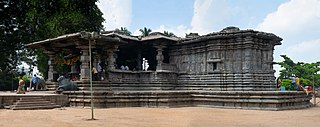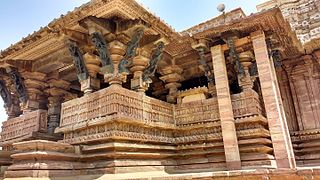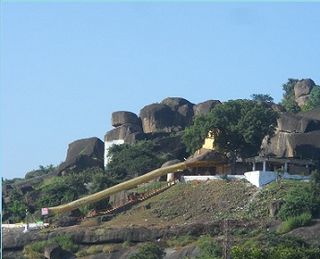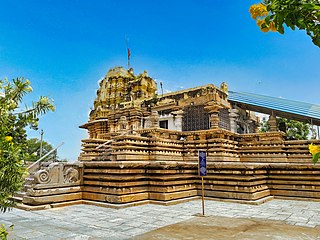
Nalgonda is a city and municipality in the Indian state of Telangana. It is the headquarters of the Nalgonda district, as well as the headquarters of the Nalgonda mandal in the Nalgonda revenue division. It is located about 90 kilometres (56 mi) from the state capital Hyderabad.

The Kakatiya dynasty was an Indian dynasty that ruled most of eastern Deccan region in present-day India between 12th and 14th centuries. Their territory comprised much of the present day Telangana and Andhra Pradesh, and parts of eastern Karnataka, northern Tamil Nadu, and southern Odisha. Their capital was Orugallu, now known as Warangal.

Hanumakonda is a major city and the district headquarters of Hanumakonda district in the Indian state of Telangana.Earlier Hanumakonda was a separate city, now The three urban cities Kazipet, Hanumakonda and Warangal are together known as Tri-Cities.The three cities are connected by National Highway 163

Rudrama Devi, also known by her regnal name Rudra-deva Maharaja, was a Kakatiya Queen-regnant who ruled substantial parts of present-day Telangana and Andhra Pradesh in southern India. She was among the few and the most successful female rulers of Indian history.

Panagal, also referred to as Panagallu or Panugallu, is a historic town located 4 km northeast from Nalgonda city in Telangana, India.

Kotipalli also known as Koti Theertham is a village located in K. Gangavaram mandal of Ramachandrapuram revenue division in Konaseema district of Andhra Pradesh, India. The temple town is also known as Kumararama of the Pancharama Kshetras, and is located 15 km from Amalapuram. Every year festivals such as Maha Sivaratri, Vaisakha Suddha Ekadasi, Aswayuja Suddha Padyami to Dwadasi and Ksheerabdi Dwadasi Teppotsavam are celebrated in this village.

The Thousand Pillar Temple or Rudreswara Swamy Temple is a historical Hindu temple located in the town of Hanamakonda, Telangana State, India. It is dedicated to Lord Shiva, Vishnu and Surya. Thousand Pillar Temple, along with Warangal Fort, Kakatiya Kala Thoranam and Ramappa Temple are added to the tentative list of World Heritage sites recognised by UNESCO.

Warangal Fort is located in Warangal District, Telangana, India. It was the capital city of Kakatiya dynasty and the Musunuri Nayakas. It appears to have existed since at least the 12th century when it was the capital of the Kakatiyas. The fort has four ornamental gates, known as Kakatiya Kala Thoranam, that originally formed the entrances to a now ruined great Shiva temple. The Kakatiyan arch has been adopted and officially incorporated into the emblem of Telanganaafter the bifurcation of Andhra Pradesh. The fort is included in the "tentative list" of UNESCO World Heritage Site and was submitted by the Permanent Delegation of India to UNESCO on 10/09/2010.
Panagal Archaeological Museum is an archaeological museum located in Panagal village in Nalgonda district, Telangana, India. It is located in the premises of Pachala Someswara temple. It is also close to the Chaya Someswara temple at a distance of 1.3 km to the west of the temple.

Chaya Someswara Temple, also known as the Chaya Someshvara Swamy Alayam or the Saila-Somesvara temple, is a Saivite Hindu temple located in Panagal, Nalgonda district of Telangana, India. It was built around the mid 11th-century during the rule of the Kunduru Chodas, supported and embellished further by later Hindu dynasties of Telangana. Some date it to late 11th to early 12th-century.

Bhoganandiswara Temple and Arunachaleswara Temple are a twin Hindu temples complex located in Nandi village in Chikkaballapur district of Karnataka, India. Ornate, beautifully carved and dedicated to Shiva, they have been variously dated between the 9th- to 10th-century CE.

The earliest temples in Telangana include the Alampur Navabrahma Temples built during the 6th century CE by the Badami Chaulukyas.
The Telangana State Tourism Development Corporation is a state government agency which promotes tourism in Telangana, a state in the Southern region of India. The retired Director General of Police Pervaram Ramulu is the appointed First chairman of Telangana State Tourism. Tourist attractions in Telangana include historical places, monuments, forts, water falls, forests and temples.

The Culture of Telangana in India has a cultural history of about 5,000 years. The region emerged as the foremost centre of culture in Indian subcontinent during the rule of Kakatiyas, the Qutb Shahis and Asaf Jahi dynasties—. The rulers patronage and interest for culinary, arts and culture transformed Telangana into a multi-cultural region where two different cultures coexist together, thus making Telangana the representative of the Deccan Plateau and its heritage with Warangal and Hyderabad being its epicenter. Hyderabadi cuisine and Kakatiya architecture both from Telangana, are on the list of UNESCO creative city of gastronomy and UNESCO World Heritage Site. The regions major cultural events celebrated are "Kakatiya Festival" and Deccan Festival along with religious festivals Bonalu, Bathukamma, Dasara, Ugadi, Sankranthi, Milad un Nabi and Ramadan.

Warangal ASI Museum is a museum located in the musical garden complex in Warangal, Telangana, India. It is maintained by Archaeological Survey of India.

Padmakshi Temple is one of the oldest temples in the Hanamakonda area of Telangana, India. It is dedicated to the Hindu goddess Padmakshi (Lakshmi), and also features Jain imagery.

Pushpagiri Temple Complex is a temple complex located in Kadapa district in Andhra Pradesh, India. Founded around 7th Century CE, it houses some of the oldest temple congregations in the region.
Khilla Ghanpur is a historic place equidistant, 25 km, from Mahabubnagar and Wanaparthy towns of Telangana state, India. It is 111 kilometers away from Hyderabad city.

Erakeswara Temple is a Saivite Hindu temple located in the western side of Pillalamarri village, Suryapet district of Telangana, India. The temple was built on the banks of the Musi river in c. 1208 CE by Erakasani, the wife of Bēti Reddi of the Recherla family who were the feudatories of Kakatiyas. Erakeswara Temple is one among the four prominent and intricately carved stone and granite temples located in Pillalamarri village—the other three are about 250 metres east of the Erakeswara temple. These include the double temples next to each other: Nameswara Temple and Trikuteswara Temple ; and the third being the Chennakesava Temple (Vishnu) in ruins that is a few hundred feet southwest of the double temples. They are all from 12th to early 13th century period.

Nameswara Temple, also known as Parvati Mahadeva Nameswara temple, is a Saivite Hindu temple located in Pillalamarri, Suryapet district of Telangana, India. It is a double temple, with the Trikuteswara Temple aligned in parallel to it on the immediate north. The Nameswara temple was constructed on the banks of the Musi river in c. 1202 CE by Namireddi of the Recherla family, who ruled this region and served as the feudatories of Kakatiyas. The genealogy of Namireddi is given in the inscription on the pillar.































